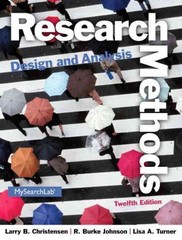Question
Radio Frequency Identification (RFID) is an automatic identification technology that has been around for a number of years and is touted as one of the
Radio Frequency Identification (RFID) is an automatic identification technology that has been around for a number of years and is touted as one of the most important innovations in several decades. The initial focus of RFID was on security as is evident in its use in the friend or foe program in Britain during WWII. In recent years the technology has been used in many areas including inventory management, process control, asset tracking and monitoring. RFID utilization enhances the timeliness of production information, creates tracking ability allowing for traceability of inventories and increases service level capabilities resulting in organizational growth and profitability. RFID technology also has implications for improving performance at the supply chain level.
RFID, while more expensive, has significant advantages over bar codesand the cost differential is rapidly narrowing. RFID tags do not require line-of-sight in order to be read and depending upon the type of tag can be read at greater distances. RFID tags can also be read so much faster than bar codes that it appears that all tags in a location are read simultaneously rather than sequentially as with bar codes. RFID has read/write capability that bar codes lack. RFID tags are more durable than bar codes and may be implanted within products assuring long-term traceability. These advantages facilitate an organization's ability to provide timely information required for agile performance.
Organizations with established enterprise resource planning (ERP) information systems have the abilities to synchronously share real-time data/information with supply chain partners. RFID technology serves to enhance the ability of manufacturing organizations to share data/information with suppliers and customers better enabling those organizations to rapidly respond to changes in customer demand. RFID technology allows the real-time capture and sharing of inventory-related information across the supply chain.
RFID technology provides additional inventory-related information on a real-time basis that can be shared synchronously with supply chain partners. This additional information enhances the ability of manufacturing organizations to respond to changes in customer demand through improved organizational agility.This enhanced agility leads to improved efficiency (operational performance) and customer satisfaction (logistics performance).
Previous research found evidence that diffusion of technology can have an advantageous effect on economic growth in and across countries. Technology diffusion in manufacturing impacts productivity in a manufacturing environment. Diffusion of information technology allows companies to be proactive, reactive, and create change. These elements are all considered to be agile activities. RFID is a technology that provides a means of collecting timely data/information, and the diffusion of RFID technology can provide ways for companies to be both proactive and reactive and to create change.
RFID systems are rapidly replacing Universal Product Codes (barcodes). To date, cost has been the major barrier to the utilization of RFID. Costs are, however, decreasing which should make RFID technology more accessible. RFID utilization has been found to enable improved manufacturing performance. More organizations are realizing the benefits of employing RFID to track inventory within the organization. Manufacturing organizations can benefit from greater inventory visibility via the real-time data/information provided by RFID technology to manage the flow of inventory. RFID technology has been found to speed up the flow of data/information allowing for greater visibility of inventories as they flow through the manufacturing processes.RFID can be used to track all types of inventory, such as raw materials, work-in-progress (WIP), and finished goods inventories, through the manufacturing process. The level of tagging (item, case, or pallet) can be crucial for an organization. Currently most items are tagged primarily at the case and pallet level, as the cost of the technology goes down, organizations will begin to tag at the item level.
The adoption of RFID technology has implications for performance at the supply chain level, as well as at the organizational level.Based on a recent review of related literature, RFID technologies may improve performance at the supply chain level by reducing inventory losses, increasing the efficiency and agility of processes, and improving information accuracy. Additionally, based on simulation results, RFID technology adoption is most beneficial within a supply chain context when the level of collaboration among the supply chain partners is relatively intensive.
read the "U.S. Manufacturers Report Greater RFID Usage" article by Sower, Green, Zelbst, and Thomas published in the RFID Journal in 2012
- What does the acronym RFID stand for?
- What is RFID?
- What is the general purpose of the article?
- List the potential benefits that RFID offers U.S. manufacturers. Which benefit do the authors consider the greatest benefit?
- Summarize the results presented in Table 1.
- Summarize the results presented in Figure 1 related to the trend in average cost of RFID tags over time.
- The authors discuss findings from other RFID-related studies. What impact has RFID technology been found to have on information sharing, agility, operational performance, organizational performance, and supply chain performance.
- Based on what you learned from the article, is it likely that U.S. manufacturers will continue to implement RFID technology?What benefits will the manufacturers reap from this continued implementation?
- Why is it important for supply chain managers to know about RFID technology?
Step by Step Solution
There are 3 Steps involved in it
Step: 1

Get Instant Access to Expert-Tailored Solutions
See step-by-step solutions with expert insights and AI powered tools for academic success
Step: 2

Step: 3

Ace Your Homework with AI
Get the answers you need in no time with our AI-driven, step-by-step assistance
Get Started


